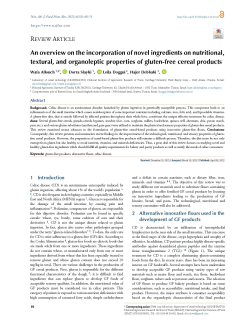Main Article Content
An overview on the incorporation of novel ingredients on nutritional, textural, and organoleptic properties of gluten-free cereal products
Abstract
Background: Celiac disease is an autoimmune disorder launched by gluten ingestion in genetically susceptible persons. This component leads to an inflammation of the small intestine which causes malabsorption of some important nutrients including calcium, iron, folic acid, and liposoluble vitamins. A gluten-free diet, that is strictly followed by affected patients throughout their whole lives, constitutes the unique effective treatment for celiac disease.
Aims: Several gluten-free cereals, pseudo-cereals, legumes, starches (rice, corn, sorghum, millets, buckwheat, quinoa, teff, chestnuts, chia, potato starch, peas, etc.), and various gluten substitutes (xanthan and gum guar) were utilized to maintain the physical and sensory properties of gluten-free cereal products. This review examined recent advances in the formulation of gluten-free cereal-based products using innovative gluten-free flours.
Conclusions: Consequently, this review presents and summarizes recent findings in the improvement of the technological, nutritional, and sensory properties of gluten-free cereal products. However, the preparation of cereal-based gluten-free products still remains a difficult process. Therefore, the diet must be not only exempt from gluten but also healthy to avoid nutrient, vitamins, and minerals deficiencies. Thus, a great deal of this review focuses on studying novel and healthy gluten-free ingredients which should fulfill all quality requirements for bakery and pastry products as well as satisfy the needs of celiac consumers.







